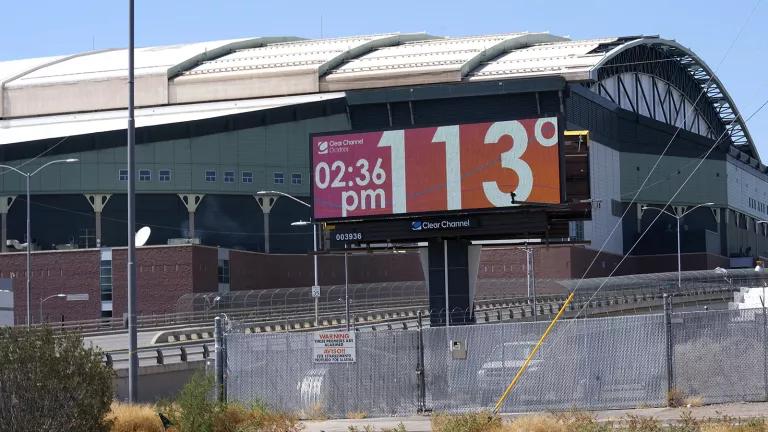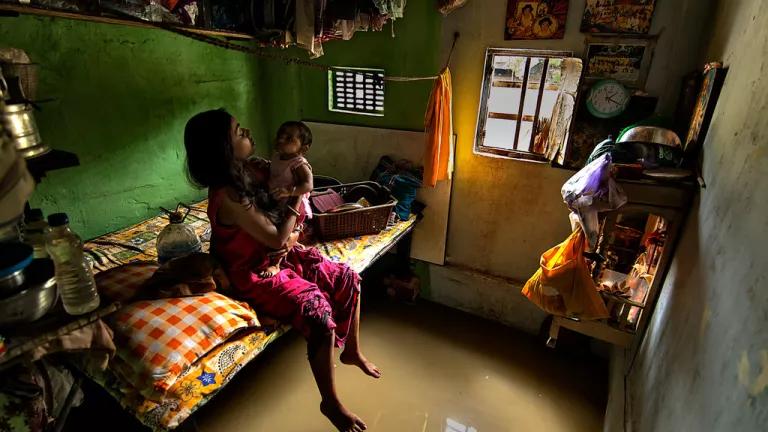The extreme weather just won’t seem to leave people alone this year.
I’m talking to an arborist to find replacements for beloved lilac bushes and one magnolia tree that just got tall enough to lend some nice summer shade, now snapped off in its prime by last weekend’s wet October snowfall that’s being called “Snowtober” by some.
My sense of humor about the year has worn thin. Neighbors across much of upstate NY and Vermont are still reeling in very serious ways from the flooding and water damage of Irene: farms and fields that were underwater, homes upended, village main streets still mending from cascades of debris and mud, all at a time when the regional and national economy is limping, at best. The preliminary tally of damages from 2011’s weather disasters already “exceed $45 billion”, according to the National Oceanic & Atmospheric Administration (NOAA). And we have nearly two months to go.
As my colleagues at NRDC like Frances Beinecke and elsewhere (Joe Romm and others) have said, what Americans are being confronted by from this record-breaking year of extremes -- storms, floods, heat, drought, wildfires – is increasingly the shape of things to come, if climate change continues unabated.
But while people are beginning to understand these local costs of climate change, there’s still a disconnect between climate change and our health.
I hope that gap might be bridged by a new report published today in the peer-reviewed journal Health Affairs, which details the tremendous costs of some events that have already happened right here in the US – types of events that are projected to worsen with more climate change. With NRDC colleagues and economists from UCSF and UC Berkeley, we estimated the health-related costs of climate change.
Those health costs exceeded $14 billion dollars and over 760,000 encounters with the health care system -- staggering figures, since they resulted from just six key climate-change related events in the US during the last decade.
The six climate change-related case studies we looked at from 2002 to 2009 in our analysis considered specific examples of extreme weather and disease events that are expected to worsen with climate change. The events included ozone air pollution, heat waves, hurricanes, outbreaks of infectious disease, river flooding, and wildfires across the US. And they led to:
- 1,689 premature deaths
- 8,992 hospitalizations
- 21,113 emergency department visits
- 734,398 outpatient visits.
This is the first report to develop a uniform method of quantifying the associated health costs for extreme weather and disease events that are expected to be exacerbated by climate change.
Since prior estimates of climate change damage costs in the US haven’t included specific health costs, they were underestimates. We need to add-in health-related costs, because these numbers are big -- in the billions.
Since we value our health, and especially our children’s and grandchildren’s health very dearly, we should think about these billion-dollar price tags. We only describe six such events; there were undoubtedly more that occurred in the last decade, so we know our total is an underestimate of the overall national health-related costs of climate change.
This illuminates an important message: climate-health preparedness pays. It will help us reduce those billions of dollars in health costs, and save lives.
You can get involved in the solution by putting pressure on our government agencies at a local and federal level to focus on climate-health preparedness. We have a responsibility to proactively engage with and respond to the transformation that’s happening now, in lots of American communities. Some states and cities are definitely starting to take the initiative to become more climate-resilient, healthier places.
Right now, there is no federal mandate that guarantees funding for climate-health research or preparedness planning.
And only 13 US states currently have health preparedness measures in their state climate change adaptation plans. The other 37 (or three-quarters of the US) lack comprehensive climate-health preparedness measures. Most of us are sitting in the cross-hairs of climate change.
NRDC’s “Climate Change Threatens Health” webpages map five major climate-health vulnerabilities across the US, so you can see how climate change affects health right in your backyard. The webpages also tell you what (if anything) is being done to prepare and adapt to climate change where you live, and actions you can take to protect your and your family’s health.
Representative Lois Capps (D-CA) just last week introduced legislation that would promote climate-health preparedness. The Climate Change Health Protection and Promotion Act would improve the public health response to climate change. The legislation would address the negative health effects related to climate change by supporting research, monitoring, planning and interagency coordination. This act deserves the public’s support -- and strong funding, too.
Proactive public health solutions to climate disasters need to be systematized now to reduce inevitable climate change-related peril. We hope the Health Affairs report provides the methodology that will allow our leaders to begin to do just that.


